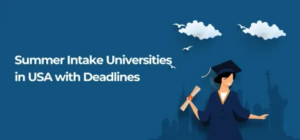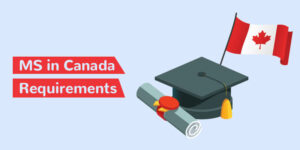What are he Steps to Studying in the USA?

If you are an international student looking for educational opportunities in the US, you are not alone. Despite the impact of the pandemic, nearly one million students from more than 200 different countries enrolled in US-based institutions alongside US students in the 2021–2022 academic year.
Still, between student visas, the application process, and cultural differences, some others may find it difficult to gauge their commitment to experiencing American university life. With our comprehensive guide on how to study in the USA, you’ll be well prepared and on your way to international student status.
Applying to USA university
Applying to universities in the US can be difficult, but the process can also be difficult for prospective US-based students. Try not to get discouraged. Here are some steps you can take to make your study abroad trip as smooth as possible.
Start developing your skills
Because U.S. universities can be competitive, it’s important to develop your skill set when starting the study abroad process. In addition to relevant language skills, you should also sharpen your critical thinking, communication (written and verbal), and time and resource management skills.
Research Colleges
Finding the right program among American colleges is all about “finding the right fit for you.” Depending on your preferences, this could mean a college:
- Offers a degree program in which you are interested
- Accepts international students from diverse cultural backgrounds to create a global community
- Facilitates sports and other activities that allow your interest and participation of international students
- Located in an ideal climate and living environment
To ensure a good fit and continued success, it’s important to research colleges before deciding which to apply to. If you don’t, you run the risk of going to a school that doesn’t suit your personal and professional interests.
Connect with institutions before applying.
One of the most resource-intensive steps you can take in the process (which many applicants overlook) is to reach out to institutions before applying. Most universities have a dedicated admissions office that handles inquiries from prospective international students. Consider reaching out and asking about available resources, such as:
- Career counseling
- Scholarship opportunities
- Mental health counseling
- Global Student Services
Another way to connect with interested institutions is to reach out to faculty, alumni, or current students through your personal network or mutual connections. Don’t worry if you don’t have one.
“Reaching out to relevant departments, or even professors, when possible is a really good place to start,” says Tomo Yamamoto, associate director of international enrollment marketing at Northeastern University. In general, universities are looking for the best candidates to apply to their programs—especially international students with interesting backgrounds—so don’t hesitate to reach out and ask for more insider perspective.
Consider the requirements.
In your research, you will come across different requirements for different universities in the application and enrollment process. Many of these requirements apply to all students, international and otherwise. For example, while most universities are now test-optional as a result of the pandemic, some colleges still require scores from standardized tests (eg, SAT, ACT, or GRE) as part of the application process. are
As an international student, you will want to be vigilant about these requirements as there will likely be additional conditions. For example, the TOEFL or IELTS exams, which aim to demonstrate proficiency in English, are common application requirements for international students.
Get your student visa.
Getting your student visa can be a long and difficult process, but a good institution will have resources to guide you. For example, Northeastern provides step-by-step instructions for applicants for F-1 student visas and J-1 student visas, depending on whether you are an incoming full-time international student or On an exchange program with a government, organization, or university sponsor, respectively.
In general, you will need to take the appropriate steps to enter the US and begin your academic career. Consider the first steps in obtaining your student visa. Typically, this will be the submission of visa supporting documents, such as Form I-20, Form DS-2019, and a valid passport.
Maintain your status
Once you’ve started your student life in the US, your journey has just begun. Once abroad, it is important to maintain your full-time, on-ground enrollment status at your institution to ensure that your visa is valid and that you can legally remain in the country. Remember, failure to do so can have serious consequences.
The good news is that most institutions have a dedicated department to ensure that their international students meet their visa requirements and maintain valid immigration status. As an international student, it is important to reach out to your Office of Global Services or equivalent resources to ensure that you are doing everything necessary to maintain your status.
Terms for full-time credit vary slightly by institution, but in general, they require class hours or credits for the term, a certain level of performance in those classes, and a certain percentage of in-person course enrollment. happens. For example, according to Northeaster’s Office of Global Services, maintaining status guidelines for undergraduate students include a minimum of 12 credit hours per term and a maximum of one online course. However, since these requirements vary from university to university, it is important to check with your specific office.
Challenges of Studying in America
Moving to and living in a new country can be difficult, especially when studying abroad. However, with proper preparation and the right tools, you can overcome these obstacles.
Cost of Living
What can scare off potential international students in many cases is the cost of living in US cities such as New York and San Francisco, notorious for their soaring housing prices and high cost of living. In addition to these high prices, tuition for American universities in these cities is also very high. However, international students who maintain F-1 visa status may be eligible for on-campus work. If you are interested in this option, it is highly recommended to constantly check the job postings on campus.
As Yamamoto says, “Tuition and other related costs are public on the university’s website. The cost of living may vary depending on each student’s lifestyle and preferences.” However, both of these aspects add to the total investment in your study abroad. As such, it’s important to research potential future returns on investment as part of your preparation process. Look at potential job opportunities that support work visas, offer a rewarding average salary, and offer positive job market forecasts to ensure you’ll be there when you graduate. You will have ROI-positive options.
Applying for a visa
There are a number of potential barriers, based on students’ individual circumstances, which should be kept in mind when applying for your student visa. For example, politics and current world events can affect how long it takes to get a visa. In extreme cases, it can even affect whether you qualify to receive it. It is important to apply for the relevant visas in time to prepare for any unforeseen obstacles.
Another tip is to use outside resources that can help. “International students check the U.S. Embassy website for more up-to-date information from the U.S. government about student visas and the application process,” Yamamoto suggests.
Cultural differences
Adapting to cultural differences can be difficult. People may speak differently than you are used to, speak rudely or loudly, or expect different social norms from you. In class, it may be difficult to find the right time to talk or it may take a little longer than you’d like to make friends.
But as every expat, ex-pat, and international student will inevitably tell you, it always gets better. In fact, being immersed in and learning about a new culture is what makes living abroad so exciting and fulfilling. Celebrating cultural differences is an essential part of studying abroad.
At Northeastern, there are many student organizations where you can connect with peers with similar interests while safely expanding your horizons and easing your transition. Likewise, the university has dedicated support services and events to help international students succeed and feel welcome on campus, including:
- Global Student Success: Provides high-quality English language, academic, and cultural support to international and non-native English-speaking students.
- Global Student Mentor Program: Support incoming international students as they transition to college life at Northeastern and the culture of the United States, foster engagement with the Northeastern community, and improve resource utilization.
- OGS Events: Attend cultural events, workshops and more hosted by the Office of Global Services.
Taking the leap to study in the US
Taking the Leap to Study in the USA
Preparing to study in the USA can be confusing and challenging, but with the right guide and an institution ready to help, it can be the start of one of the most memorable experiences of your life. Northeastern has a dedicated team to ensure that their international students are well prepared, adjusted and successful.








